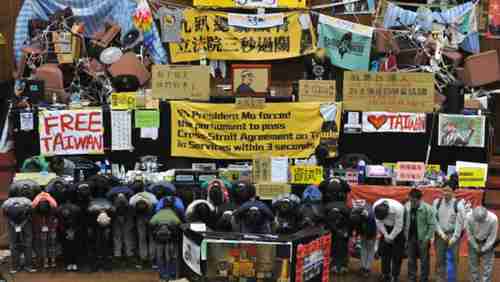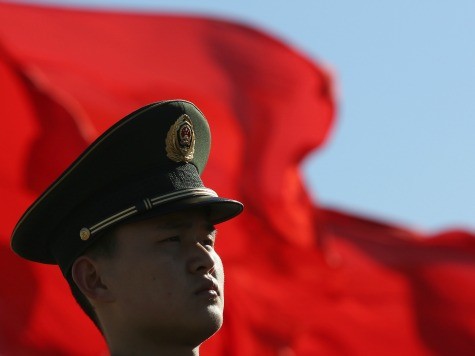 This morning’s key headlines from GenerationalDynamics.com
This morning’s key headlines from GenerationalDynamics.com
- Taiwan voters choose independence from China
- Sunflowers and Umbrellas
Taiwan voters choose independence from China

Student protests in Taiwan in April of this year (AFP)
Taiwan’s ruling nationalist party KMT (Kuomintang) suffered disastrouslosses in local elections across Taiwan on Saturday, giving victoriesto the opposing DPP (Democratic Progressive Party), and forcing theresignation of the prime minister. Thousands of municipalities,including the capital city Taipei, that had been ruled for years byKMT mayors and politicians, will now be ruled by DPP mayors andpoliticians.
The Kuomintang (KMT) is the modern day incarnation of ChiangKai-shek’s original nationalist party of soldiers that fought againstMao Zedong’s Communist Revolution and lost, and fled to Hong Kong,then a British colony, and from there to Formosa (Taiwan) in 1949, atthe conclusion of the civil war. The KMT position has always beenthat Taiwan would reunite with China.
KMT held an iron grip on power in Taiwan after the war, and that onlybegan to fade in the 1980s with the founding of the DPP. However, the1989 Tiananmen Square massacre in Beijing, which people in Taiwanviewed with horror, proved to be a catalyst in turning Taiwanesepeople against Beijing, and by 2000 the DPP won a national election.A DPP corruption scandal in 2006 put KMT back into power, and KMTofficials have been working closely with Beijing officials to wooTaiwan’s public to voluntarily want reunite with China.
The policy hasn’t really been effective. There are two groups ofpeople who don’t want to reunite. One group is the indigenousTaiwanese people who lived there before 1949, and who have suffered atthe hands of the KMT. Young people generally form the second group,and they distrust China and they distrust the KMT for selling out toChina. Central News Agency (Taiwan) and BBC and Forbes
Sunflowers and Umbrellas
In April of this year, hundreds of university students and otheractivists protested the proposed Cross-Strait Services Trade Agreement(CSSTA), which KMT had negotiated with Beijing in secret. Thestudents occupied the legislative chamber for several days, and movedto occupy the cabinet offices. This triggered a violent response fromthe police. The scenes of bloodied protesters, injured policeofficers and water cannon trucks galvanized the resolve of theprotesters.
In the first week of the occupation of the legislature, a supporterbrought bunches of sunflowers to the building to symbolize the need tolet sunlight into the black box of KMT negotiations between Taiwan andmainland China. The protesters became known as the Sunflower StudentMovement.
The Sunflower movement fizzled out as the summer began, but over inHong Kong a new protest began, which later came to be known as theUmbrella Movement, because protesters used umbrellas to fend offpolice tear gas. In fact, it was the use of tear gas that galvanizedthe Hong Kong protesters, just as police violence galvanized theTaiwan protesters last Spring.
The two protests have become synergistic in the sense that each one isproviding energy to the other. According to some reports, the leadersof the two protests are helping each other out, providing mutualsupport and strategies.
- Taiwan will have general elections in 2016, Hong Kong in 2017.
- Saturday’s local elections suggest that the separatist DPP is going to win the presidency 2016, which will concern and possibly infuriate Beijing.
- Beijing has “fixed” the Hong Kong elections by not permitting any candidate to run for office unless selected by Beijing. Certainly no separatist will be permitted to run.
- Protesters in both cities are galvanized by any show of violence by security forces because they all well remember Beijing’s 1989 Tiananmen Square massacre.
The anti-Beijing movement in Taiwan really took off after theTiananmen Square massacre, and each new show of force by governmentofficials serves to renew the contempt that these protesters have forBeijing. With the KMT in power, Beijing has followed a conciliatorypolicy towards Taiwan, but in the months to come if it looks like theDPP is going to come back into power in 2016, then Beijing may feelforced to take some military action. The China Story (April) and Thinking Taiwan
KEYS: Generational Dynamics, China, Taiwan, KMT, Kuomintang,DPP, Democratic Progressive Party, Chiang Kai-shek,Cross-Strait Services Trade Agreement, CSSTA,Sunflower Student Movement, Hong Kong, Umbrella movement,Tiananmen Square massacre
Permanent web link to this article
Receive daily World View columns by e-mail

COMMENTS
Please let us know if you're having issues with commenting.